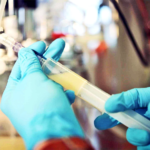Middle-aged women with elevated levels of heavy metals are more likely to have depleted ovarian function and egg reserves, which may lead to earlier menopause and its negative health effects, a new study shows.
Researchers reviewed data on hundreds of women approaching menopause and found that the presence of cadmium, mercury, and arsenic in their urine was connected to low levels of anti-Müllerian hormone (AMH).
The heavy metals are commonly found in drinking water, air pollution, and some foods, notably seafood and rice. The metals are considered endocrine-disrupting chemicals that can cause infertility, cancers, and other diseases.
AMH measures ovarian reserve, or the number of eggs available for fertilization or menstruation. Menopause is the time of life when hormone depletion ends monthly menstruation and sets off many changes to women’s health and wellness.
The observed magnitude of associations between heavy metals and AMH was stronger than the association between smoking and AMH, which is a known risk factor for depleted ovarian reserve, according to the study published in the Journal of Clinical Endocrinology & Metabolism.
“Widespread exposure to toxins in heavy metals may have a big impact on health problems linked to earlier aging of the ovaries in middle-aged women, such as hot flashes, bone weakening, and osteoporosis, higher chances of heart disease, and cognitive decline,” says study author Sung Kyun Park, associate professor of epidemiology and environmental health sciences at the University of Michigan School of Public Health.
“Our study linked heavy metal exposure to lower levels of anti-Müllerian hormone in middle-aged women. AMH tells us roughly how many eggs are left in a woman’s ovaries. It’s like a biological clock for the ovaries that can hint at health risks in middle age and later in life.”
Using data from the longitudinal Study of Women’s Health Across the Nation, Park and colleagues reviewed 2,252 repeated measurements of AMH in 549 women within 10 years after their final menstrual period. The women in the study were ages 45 to 56 and ethnically diverse: 45% white, 21% Black, 15% Chinese, and 19% Japanese.
“Given that heavy metals are widespread in the general population and urinary metal concentrations measured in our study were comparable to the general female population across the United States, the potential adverse effects of heavy metals on ovarian function should be of significant public health concern,” Park says.
Prior research offers toxicological evidence that heavy metals may negatively affect reproductive health. Only a few studies have explored associations of cadmium and lead with AMH, reporting that cadmium may alter AMH concentrations in pregnant women and premenopausal women ages 30 to 45. The new study focused on perimenopausal women.
This information may enable researchers to address adverse health outcomes known to be associated with metals and with reproductive hormone changes such as premature menopause, bone loss, and osteoporosis, increased risks of cardiovascular disease, cognitive decline, and vasomotor symptoms, according to the study authors.
“We see this significant public health concern, which may also have implications for women of all ages,” Park says.
The researchers say their findings require further investigation, particularly in a younger population, to fully understand the role of heavy metals as potential ovarian toxicants that diminish ovarian reserves.
Additional coauthors are from the University of Michigan and the University of California, Davis.
Source: University of Michigan
Author Profile
- "Center" Bias Rating
- Futurity is a nonprofit website that aggregates news articles about scientific research conducted at prominent universities in the United States, the United Kingdom, Canada, Europe, Asia, and Australia. It is hosted and edited by the University of Rochester.
Latest entries
 ScienceApril 29, 2024Team pins down huge cost of mental illness in the US
ScienceApril 29, 2024Team pins down huge cost of mental illness in the US ScienceApril 28, 2024Bacteria could replace fossil fuels for making valuable chemicals
ScienceApril 28, 2024Bacteria could replace fossil fuels for making valuable chemicals ScienceApril 28, 2024Early trauma cuts squirrel lifespans
ScienceApril 28, 2024Early trauma cuts squirrel lifespans ScienceApril 27, 2024Alzheimer’s moves faster in people with Down syndrome
ScienceApril 27, 2024Alzheimer’s moves faster in people with Down syndrome

